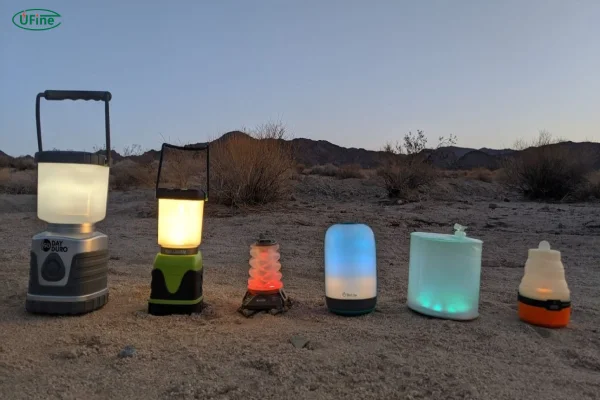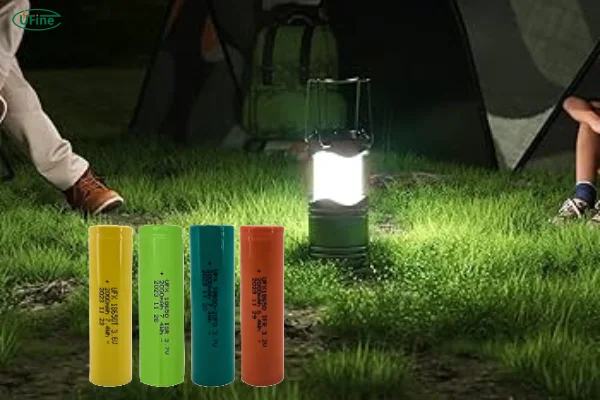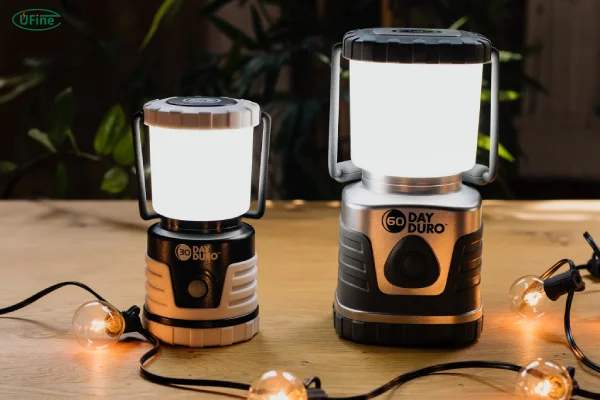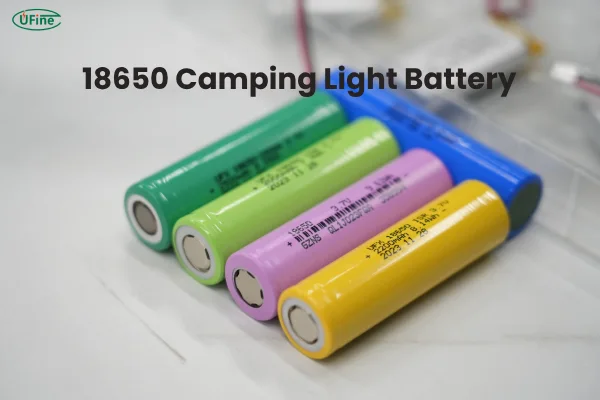
- Part 1. Types of camping lights and their unique power demands
- Part 2. Battery types: Which one is right for you?
- Part 3. Rechargeable vs disposable batteries
- Part 4. How to read battery specs?
- Part 5. Off-Grid charging: solar, USB, and crank solutions
- Part 6. Maximize your battery life
- Part 7. Safe handling and storage of batteries outdoors
- Part 8. Ufine Battery: powering your camping experience and beyond
- Part 9. FAQ
A great battery can mean peace of mind. A poor one can leave you stressed and stumbling in the dark. In this guide, we’ll dive deep into how camping light batteries work, which types are best for different situations, and how to power your adventures better.
Part 1. Types of camping lights and their unique power demands
Not all camping lights are created equal — and neither are their batteries. Knowing the differences is the first step to choosing the right power solution.
Lanterns
Camping lanterns offer all-around illumination and are ideal for lighting up your entire tent or campsite. Many lanterns use D-cell batteries, but more advanced models now run on rechargeable lithium-ion packs for longer runtime and lighter weight.
Headlamps
When you need light that moves with you — for hiking, cooking, or late-night walks — headlamps are essential. These usually use AAA or AA batteries, but high-performance headlamps increasingly rely on 18650 lithium batteries due to their compact size and superior power.
Flashlights
From basic to tactical, flashlights are powerful tools in any camper’s kit. Most modern camping flashlights favor Li-ion batteries like the 18650 because they provide high current and long runtimes, making them ideal for intense outdoor use.
String Lights and Decorative Lights
These add a warm ambiance to your site and often run on USB-powered rechargeable packs or AA batteries. They require less power but still need reliable energy to last all night.
Different lights = different battery needs. So think about how much light you need, for how long, and in what weather conditions.
Part 2. Battery types: Which one is right for you?
Understanding the types of batteries used in camping lights helps you make a smart, safe, and efficient choice.
Alkaline Batteries (AA, AAA, D-cell)
Widely available and cheap, alkaline batteries are convenient — but they’re not perfect. Their shelf life is decent, but they drain quickly in high-drain devices like LED lights, and they don’t handle cold well.
Understanding the Difference Between AA and AAA Batteries
Nickel-Metal Hydride (NiMH) Rechargeables
A better long-term option, NiMH batteries are reusable and more eco-friendly. However, they self-discharge over time and need frequent charging. Still, for budget-conscious campers, they’re a solid upgrade over disposables.
Lithium-ion Batteries (like 18650, 21700)
These are the gold standard for modern camping lights. They offer high energy density, longer runtimes, and reliable performance in low temperatures. They’re rechargeable and often used in flashlights, lanterns, and headlamps.
LiFePO4 Batteries
LiFePO4 (Lithium Iron Phosphate) batteries are incredibly safe, stable, and long-lasting. They are perfect for extended trips where safety and reliability matter. They also hold up better to overcharging, overheating, and rugged use.
Part 3. Rechargeable vs disposable batteries
Should you go rechargeable or stick with disposables? The choice depends on your habits, destination, and budget.
Disposable Batteries
Great for emergencies or one-night trips. Easy to pack spares. But they’re wasteful and unreliable in cold temperatures.
Rechargeable Batteries
Ideal for regular campers or long journeys. While the initial cost is higher, they save you money over time. And if you pair them with solar chargers or power banks, they can be recharged even in the wild.
Here’s a tip: combine both. Use rechargeables for your main lights, and keep a set of high-quality disposable batteries for backup — just in case.
Part 4. How to read battery specs?
It’s easy to get confused by technical labels like “mAh” or “3.7V.” But once you understand them, you can choose smarter.
Capacity (mAh)
Measured in milliamp-hours (mAh), this tells you how much energy a battery holds. Higher mAh = longer life. For example:
- A 2600mAh battery in a headlamp might last 5–10 hours depending on brightness
- A 5000mAh lithium battery could run a lantern all night on medium setting
Voltage
Most lithium-ion camping batteries are 3.6V or 3.7V. Make sure the battery matches your light’s required voltage — mismatching can damage your gear or lower performance.
Part 5. Off-Grid charging: solar, USB, and crank solutions
You’re in the mountains. No outlets. No power lines. How do you keep your lights going?
Solar Charging
Solar panels are great if you have clear skies. Pair them with a USB camping lantern or a lithium power bank to charge during the day and light up at night.
USB Charging
More camping lights now support USB recharging. That means you can charge from your car, power bank, or solar panel. It’s clean, fast, and simple.
Hand-Crank Lights
They’re not glamorous, but they work. Crank-powered camping lights are ideal for emergencies. A few minutes of cranking gives you short bursts of light — just enough to find your gear or start a fire.
Part 6. Maximize your battery life
Battery management is more than tech — it’s a mindset. Here’s how to make your camping light batteries last longer:
- Dim your lights when full brightness isn’t needed
- Turn off devices when not in use
- Keep lithium batteries warm in cold climates (inside your sleeping bag works!)
- Use red-light mode to conserve energy
- Pre-charge everything before your trip
- Carry a power bank or portable solar panel for emergency recharges
Smart packing and usage mean fewer surprises and more fun.
Part 7. Safe handling and storage of batteries outdoors
Camping is about being prepared. But poor battery handling can lead to serious problems.
- Never mix old and new batteries — it causes leaks and ruins devices
- Avoid overcharging rechargeable batteries
- Store batteries in a dry, cool place
- Use proper battery cases, especially for lithium batteries
- Dispose of old batteries responsibly — pack them out with your trash
Battery fires are rare but dangerous. Treat them with respect, and they’ll serve you well.
Part 8. Ufine Battery: powering your camping experience and beyond
If you’re looking for custom lithium camping light batteries that deliver both safety and performance, look no further than Ufine Battery.
Ufine Battery is a leading custom lithium battery manufacturer based in China. They specialize in:
- Lithium polymer batteries
- LiFePO4 batteries
- 18650 batteries
- Cylindrical, ultra-thin, high-temperature, and high-rate batteries
Whether you’re outfitting a personal camping setup or building custom outdoor gear, Ufine can provide batteries in any size, voltage, capacity, or discharge rate — made to your exact needs.
Need help choosing or designing the right camping light battery?
Contact Ufine Battery today to discuss your requirements and get expert advice.
Part 9. FAQ
Can I take camping light batteries on a plane?
Yes! Most batteries are allowed in carry-on. But check airline rules for lithium-ion batteries. Always keep them in original packaging or a battery case.
What’s the best battery for cold weather camping?
Lithium batteries work better than alkaline in the cold. Rechargeables can also perform well if kept warm.
How long does a camping lantern battery last?
It depends! A battery-powered LED lantern can last 10–50 hours depending on brightness and battery type. Check your product’s specs.
Are there eco-friendly camping light batteries?
Yes! Rechargeable NiMH batteries are a great green choice. Also look for solar-powered camping lights.
Should I bring extra batteries on every trip?
Absolutely. Always bring extras — even if your light is rechargeable. Power banks, spare AA or AAA batteries, or a small solar panel are smart additions.
Related Tags:
More Articles
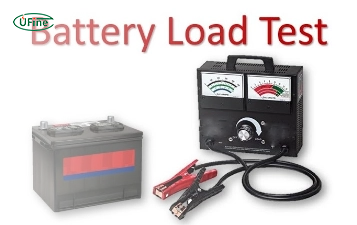
Battery Load Test: A Comprehensive Guide
Step-by-step battery load test guide for car, solar & industrial use. Learn how to load test a battery, interpret voltage charts, and avoid common mistakes.
The Comprehensive Guide to Battery Balancing and Battery Balancer
Discover how battery balancers improve lithium battery performance, lifespan, and safety. Learn types, functions, and tips to choose the right balancer.
What Is the Best Voltage for a Chainsaw Battery?
Compare 12V-80V chainsaw batteries for light pruning, medium firewood, and professional cutting. See best battery chainsaw with runtime charts and safety tips.
Lithium VS. Alkaline Batteries: A Comprehensive Comparison
Lithium batteries last 3–7× longer than alkaline and perform better in cold weather. Compare lifespan, cost, safety, and best uses to choose the right battery.
Comparing Lithium-Sulfur and Lithium-Ion Batteries: Which is Right for You?
Compare lithium-sulfur (Li-S) and lithium-ion batteries on energy, lifespan, cost, safety, and applications. Best choice for drones, EVs, and electronics.
